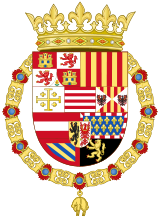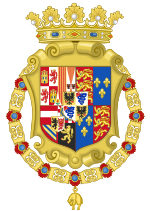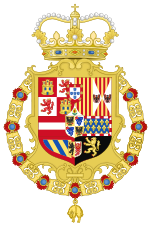- Coats of arms of Spanish Monarchs in Italy
-
The Spanish monarchs of the House of Habsburg used separate versions of their royal arms as sovereigns of the Kingdom of Naples-Sicily and the Duchy of Milan with the arms of these territories.
The Kingdom of Sicily was ruled as an independent kingdom by relatives or cadet branch of the house of Aragon until 1409 and thence as part of the Crown of Aragon.The Kingdom of Naples was ruled by the Angevin ruler René of Anjou until the two thrones were reunited by Alfonso V of Aragon, after the successful siege of Naples and the defeat of René on June 6, 1443.[1] Eventually, Alfonso of Aragon divided the two kingdoms during his rule. He gave the rule of Naples to his illegitimate son Ferdinand I of Naples, who ruled from 1458 to 1494, and Aragon and Sicily to Alfonso's brother John II of Aragon. Eventually the Kingdom of Naples was reunited with the Aragonese Kingdom.The titles were held by the Aragonese kings of the Catalan-Aragonese Crown until 1516, followed by the Kings of Spain until the end of the Spanish branch of the House of Habsburg in 1700.
When Francesco II Sforza, duke of Milan died without heirs in 1535, emperor Charles V got the Duchy. The Emperor held the Duchy throughout, eventually investing it on his son prince Philip. The possession of the Duchy by Spain was finally recognized by the French in the Treaty of Cateau-Cambrésis in 1559.- The Royal Arms of Sicily after 1282 were blazoned Per saltire Aragon and Hohenstaufen: 1/4 are the arms of Aragon (Or, four pales Gules), and 2/3 are the arms of the House of Hohenstaufen (Argent, an eagle Sable).
- The Royal Arms of Naples used by the monarchs of the House of Trastámara were borne by Charles III of Naples as his heirs: the arms of Hungary (Barry of eight Gules and Argent), the arms of the Kingdom of Jerusalem (Argent, the Jerusalem Cross Or) and the ancient arms of Anjou (Azure semé-de-lys Or charged with a label of three points Gules). In 1504 Ferdinand II of Aragon became monarch of Naples and added the arms of Charles III in his heraldry but he removed the arms of Anjou.[2]
- The Ducal Arms of Milan (used at the time of the House of Sforza) were the biscione, a heraldic charge showing in Argent an Azure serpent in the act of consuming a human quartering, with the Imperial eagle (the earlier single-headed).
The Kingdom of Naples-Sicily and the Duchy of Milan remained in Spanish hands until the War of the Spanish Succession in the early 18th century, when Milan was conquered by the Austrians and Naples-Sicily passed to the House of Savoy.Italian version of the arms of Charles I of Spain (Charles V as Holy Roman Emperor) Coat of Arms Dates Details 

Charles I
Charles V
as Holy Roman Emperor
1520-1556Heraldic Divisions - Crown of Castile
(Arms of Castile and León,
Granada enté en point) - Crown of Aragon
- Kingdom of Navarre
- Kingdom of Sicily
- Archduchy of Austria
- Duchy of Burgundy (Modern arms)
- Duchy of Burgundy (Ancient arms)
- Duchy of Brabant
- Duchy of Flanders and Tirol
(Lower inescutcheon) - Kingdom of Jerusalem
- Kingdom of Hungary
- Granada
(Enté en point)
Other elements
Double-headed eagle of the Holy Roman Empire, the heraldic imperial crownVersions of the Spanish Royal Arms used by the Monarch as Sovereign of Naples and Sicily Coat of Arms Dates and Monarch Details 

Philip of Spain
Prince of Asturias and Girona
1554-1556
Philip II
1556-1598Heraldic Divisions - Crown of Castile
(Arms of Castile and León,
Granada enté en point) - Crown of Aragon
- Kingdom of Jerusalem
- Kingdom of Hungary
- Kingdom of Sicily
- Archduchy of Austria
- Duchy of Burgundy (Modern arms)
- Duchy of Burgundy (Ancient arms)
- Duchy of Brabant
- Duchy of Flanders and Tirol
(Lower inescutcheon)
Heraldic Ornaments
Open royal crown of Naples and Sicily, the collar of the Order of the Golden Fleece

Philip III
1598-1621
Philip IV
1621-1665Heraldic Divisions - Crown of Castile
(Arms of Castile and León) - Crown of Aragon
- Kingdom of Jerusalem
- Archduchy of Austria
- Duchy of Burgundy (Modern arms)
- Duchy of Burgundy (Ancient arms)
- Duchy of Braban
- Kingdom of Sicily
- Kingdom of Hungary
Heraldic Ornaments
Open royal crown of Naples and Sicily

Charles II
1665-1700Heraldic Divisions - Crown of Castile
(Arms of Castile and León) - Crown of Aragon
- Kingdom of Jerusalem
- Archduchy of Austria
- Duchy of Burgundy (Modern arms)
- Duchy of Burgundy (Ancient arms)
- Duchy of Braban
- Kingdom of Sicily
- Kingdom of Hungary
Inescutcheon - Duchy of Flanders
- Tirol
Heraldic Ornaments
Closed royal crown of Naples and Sicily, the collar of the Order of the Golden FleeceVersions of the Spanish Royal Arms used by the Monarch as Sovereign of Milan Coat of Arms Dates and Monarch Details 

Philip of Spain
Prince of Asturias and Girona
1554-1556
Philip II
1556-1558
King Consort of England and Ireland
1554-1558Heraldic Divisions Dexter (To viewer's left)
- Crown of Castile
(Arms of Castile and León) - Crown of Aragon and Kingdom of Sicily
- Kingdom of Granada
(enté en point)
- Archduchy of Austria
- Duchy of Burgundy (Modern arms)
- Duchy of Burgundy (Ancient arms)
- Duchy of Brabant
- Duchy of Flanders and Tirol
(Lower inescutcheon)
Sinister (To viewer's right)
- Kingdon of England
- Kingdom of France (Modern)[3]
Inescutcheon - Duchy of Milan
Heraldic Ornaments
The Ducal Crown of Milan, the collar of the Order of the Golden Fleece

Philip II
1558-1580Heraldic Divisions Dexter (To viewer's left)
- Crown of Castile
(Arms of Castile and León) - Crown of Aragon
- Kingdom of Jerusalem
- Kingdom of Hungary
- Kingdom of Sicily
- Archduchy of Austria
- Duchy of Burgundy (Modern arms)
- Duchy of Burgundy (Ancient arms)
- Duchy of Brabant
- Duchy of Flanders and Tirol
(Lower inescutcheon)
Sinister (To viewer's right)
- Duchy of Milan
Heraldic Ornaments
The Ducal Crown of Milan, the collar of the Order of the Golden Fleece

Philip II
1580-1598
Philip I,
as King of Portugal
1580-1598
Philip III/II
1598-1621
Philip IV
1621-1665
Philip III
as King of Portugal
1621-1640
Charles II
1665-1700Heraldic Divisions - Crown of Castile
(Arms of Castile and León) - Crown of Aragon
- Kingdom of Sicily
- Kingdom of Granada
(enté en point) - Kingdom of Portugal
(Upper inescutcheon)
- Archduchy of Austria
- Duchy of Burgundy (Modern arms)
- Duchy of Burgundy (Ancient arms)
- Duchy of Brabant
- Duchy of Flanders and Tirol
(Lower inescutcheon)
Inescutcheon (Central) - Duchy of Milan
Heraldic Ornaments
Closed Royal Crown, the collar of the Order of the Golden FleeceSee also
- Historical Spanish coats of arms
- Duchy of Milan
- Kingdom of Naples
- Kingdom of Sicily
- Monarchs of Spain
- Italian heraldry
- Spanish heraldry
Notes
- ^ Allan W. Atlas (1985). Music at the Aragonese court of Naples. Cambridge University Press. p. 1. ISBN 0521248280
- ^ (Spanish) Francisco Olmos, José María de. «La moneda napolitana de Fernando el Católico, documento propagandístico de la unidad de las coronas», pp.141-162. Revista General de Información y Documentación, 3 (2001). Madrid, Universidad Complutense. PP. 155-186, ISSN 1132-1873.
- ^ The order in what are presented the English and French arms is altered respect the usual in England.
References
- (Spanish) Francisco Olmos, José María de. «Las primeras acuñaciones del príncipe Felipe de España (1554-1556): Soberano de Milán Nápoles e Inglaterra». «The First Coins of Prince Felipe of Spain (1554-1556): Sovereign of Milan, Naples and England», pp.165-166. Documenta & Instrumenta, 3 (2005). Madrid, Universidad Complutense. PP. 155-186.
- Menéndez-Pidal De Navascués, Faustino; «El escudo»; Menéndez Pidal y Navascués, Faustino; O´Donnell, Hugo; Lolo, Begoña (1999). Símbolos de España. Madrid: Centro de Estudios Políticos y Constitucionales. ISBN 84-259-1074-9.
Categories:- Spanish coats of arms
- Italian coats of arms
Wikimedia Foundation. 2010.
